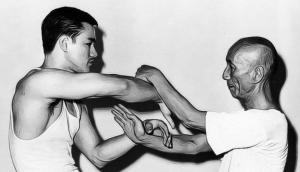黐手 The True Way of Wing Chun Chi Sau
Posted By : T. Taganashi
Date: Jul 3, 2017
Chi Sau (translated - sticky hands) is a special training exercise unique to the fighting system of Wing Chun Kung Fu; it teaches sensitivity & adaptability and provides a reasonably realistic platform for the Wing Chun man to practice his techniques. (Primarily those used in close combat range.) There are three basic forms of Chi Sau practice: Dan Chi Sau (single hand), Poon Sau (two handed “rolling hands”), and Sheung Chi Sau (free flow practice). The goal is to be able to apply all the movements from Wing Chun's three empty hand forms affectively and efficiently. Smoothly adapting to your opponents movements and reactions to your movements. In advanced stages Chi Sau is practiced while standing on a small table, while blindfolded, or both.
A lot of people practice Chi Sau as a sort of tag game where the one who gets the most hits wins, but this is not the true way of practice. In reality, at the close range in which Chi Sau is practiced striking or "tagging" is the easy part. Not getting hit is the hard part. The concentration during Chi Sau should be on sensing your opponent’s energy and reacting to his movements, a difficult task when you are spending all of your energy on attacking. Furthermore a good Wing Chun man will use this energy against you in a real fight utilized the theories of "Simultaneous Attack and Defense" and "Two Directional Force". In the long run if Chi Sau is continually practiced in this manner the Wing Chun man will begin to subconsciously rely on this aggressive method as a combat strategy. Over relying on reckless aggressive attacking at close range is a sure way to get "popped" by an equally aggressive and determined opponent. And, it will most likely lead to grappling as your opponent will also be in range to trap your hands as he tries to stop your attack. This situation is very much the same way as how MMA fighters end up clinching just before they go to the ground. Needless to say once you go to the ground your striking ability will be severely limited. I always advise my students that if they are intent on entering and fighting at close range, then they had better be well trained in grappling and ground fighting. Or ~ (I should add), have the power to take their opponent out with one or two punches.
To develop close range combat efficiency and work on solidifying your standing structure the best way to practice Chi Sau is at a moderate speed, combined with short bursts of energy, and intervals of fast movement. While at the same time moving smoothly in and out from all out "Trapping" (hand immobilizing) to simple "Rolling Hands". Engaging and disengaging with your partner in a rhythmic yet broken pattern. Maintaining a calmness of both mind and body.
The new fad in Wing Chun is Chi Sau competitions. This once again goes against the true purpose of Chi Sau and Kung Fu in general. As Chi Sau competition begins to flourish the fear is that many students (and teachers) will gain a false sense of Kung Fu superiority through their doing well in these competitions with no true measure of whether their striking was effective or not. This illusion will overshadow the true essence of Wing Chun Kung Fu, which is in the ability to transmit power and energy into the target as simply and affectively as possible. In an interview with Black Belt Magazine Ip Ching (Son of Grandmaster Ip Man) was asked which elements of Wing Chun his father practiced the most. He said that it was Sil Lim Tao form and Punching. This is very interesting. Many Wing Chun men would choose to dominate their opponent (or at least try) with a series of complex hand immobilizing attacks. I on the other hand, would prefer to end the confrontation with a simple single direct attack. That is combat efficiency.
~ Taganashi
Other articles by sifu


